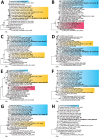Sub-Saharan Africa and Eurasia Ancestry of Reassortant Highly Pathogenic Avian Influenza A(H5N8) Virus, Europe, December 2019
- PMID: 32568059
- PMCID: PMC7323556
- DOI: 10.3201/eid2607.200165
Sub-Saharan Africa and Eurasia Ancestry of Reassortant Highly Pathogenic Avian Influenza A(H5N8) Virus, Europe, December 2019
Abstract
We report detection of a highly pathogenic avian influenza A(H5N8) clade 2.3.4.4b virus in Europe. This virus was generated by reassortment between H5N8 subtype virus from sub-Saharan Africa and low pathogenicity avian influenza viruses from Eurasia.
Keywords: Eurasia; Europe; ancestry; clade 2.3.4.4b; highly pathogenic influenza A(H5N8) virus; influenza; influenza virus; phylogeny; reassortant viruses; respiratory infections; sub-Saharan Africa; subtype; viruses.
Figures


References
-
- Poen MJ, Venkatesh D, Bestebroer TM, Vuong O, Scheuer RD, Oude Munnink BB, et al. Co-circulation of genetically distinct highly pathogenic avian influenza A clade 2.3.4.4 (H5N6) viruses in wild waterfowl and poultry in Europe and East Asia, 2017-18. Virus Evol. 2019;5:vez004. 10.1093/ve/vez004 - DOI - PMC - PubMed
-
- Abolnik C. Outbreaks of clade 2.3.4.4 H5N8 highly pathogenic avian influenza in 2018 in the northern regions of South Africa were unrelated to those of 2017. Transbound Emerg Dis. 2019; [Epub ahead of print]. - PubMed
MeSH terms
LinkOut - more resources
Full Text Sources
Medical

